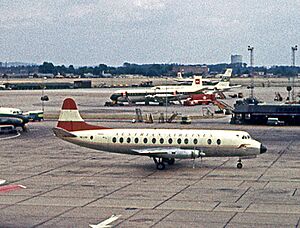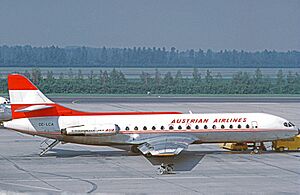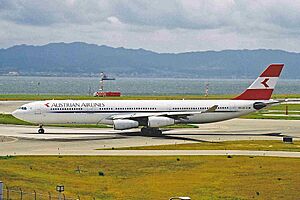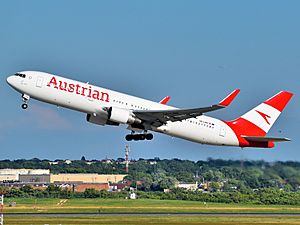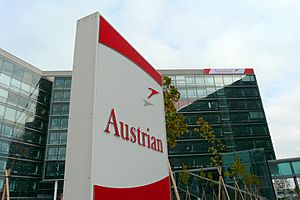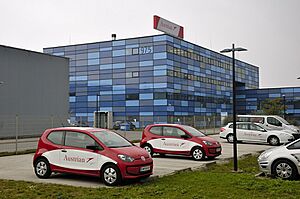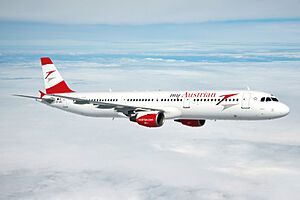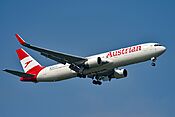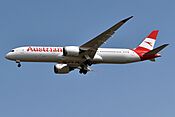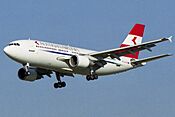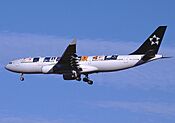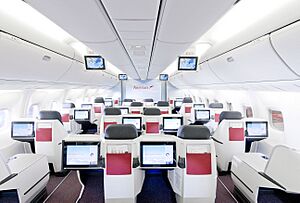Austrian Airlines facts for kids
An Austrian Airlines Boeing 777-200ER
|
|
| Founded | 3 May 1923 (as ÖLAG) |
|---|---|
| Commenced operations | 31 March 1958 |
| Hubs | Vienna International Airport |
| Frequent-flyer program | Miles & More |
| Alliance | Star Alliance |
| Fleet size | 67 |
| Destinations | 121 |
| Parent company | Lufthansa Group |
| Headquarters | Schwechat, Austria Jurisdiction: Vienna |
| Key people | Annette Mann (CEO) |
| Revenue | |
| Operating income | |
| Employees | 5,659 (as of December 2022) |
Austrian Airlines, often called Austrian or AUA, is the main airline of Austria. It is part of the Lufthansa Group, a big German airline company. Austrian Airlines has its main office and hub (a central airport for flights) at Vienna International Airport in Schwechat, Austria. As of July 2016, the airline flew to six places within Austria and over 120 international spots in 55 countries. Austrian Airlines is also a member of the Star Alliance, a group of airlines that work together.
The airline was formed in 1957 when Air Austria and Austrian Airways merged. However, its roots go back to 1923 when Austrian Airways was first created. For a long time, the Austrian government owned the airline. On March 31, 1958, Austrian Airlines started its first regular flights. It flew a rented Vickers Viscount plane from Vienna to Zürich and London. Later, it bought its own Viscount planes.
In 1963, Austrian Airlines ordered its first jet-powered plane, the Sud Aviation Caravelle. Over the years, it added many different jet planes, like the Douglas DC-9 and McDonnell Douglas MD-80. By the end of 1971, all of Austrian Airlines' planes were jets. In the 1980s and 1990s, the airline added planes from Airbus, Boeing, and Fokker.
During the 1990s, Austrian Airlines looked for new partnerships with other airlines. It also wanted to fly to more far-off places, starting new routes to China and South Africa. In 2000, Austrian Airlines joined the Star Alliance. In the 2000s, the airline grew by buying other airlines like Rheintalflug and Lauda Air. In 2003, it started using the shorter name "Austrian."
Austrian Airlines faced financial challenges in the 2000s. In 2009, the Lufthansa Group bought Austrian Airlines. This happened after the European Commission approved the sale. After being bought, the airline changed its routes, updated its look, and worked to save money. In 2012, all Austrian Airlines flights were moved to its smaller airline, Tyrolean Airways, which flew under the Austrian name. But in 2015, all flights were moved back to Austrian Airlines, and Tyrolean Airways became part of the main company. The airline continued to update its planes and routes in the late 2010s.
Contents
A Look Back: Austrian Airlines History
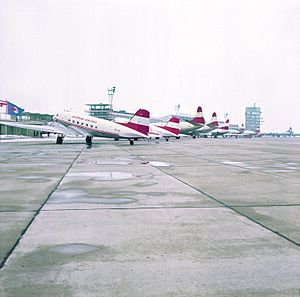
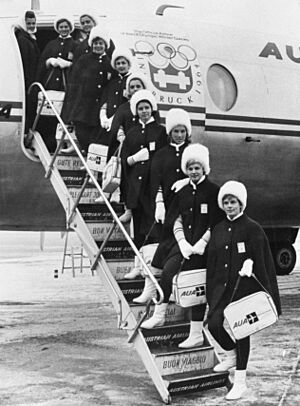
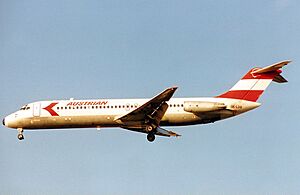
Starting Up: The Early Years
On May 3, 1923, Walter Barda-Bardenau got permission to start an airline in Austria. This new company was called Österreichische Luftverkehrs AG. He owned a small part of it, while a railway company and Junkers-Werke owned the rest.
The first planes were Junkers F 13s. On May 14, 1923, the first flight went from Vienna to Munich. The airline flew to cities like Munich, Budapest, and Graz. Seaplanes were used for flights within Austria.
In 1927, the company got new planes with help from the government. It also started working with Deutsche Luft Hansa, a German airline. They planned routes together to places like Berlin and Milan. By the 1930s, Austrian Airlines grew very fast. It became one of the biggest airlines in Europe.
In 1938, Austria became part of Nazi Germany. The airline's plans for new routes were stopped. By 1939, Lufthansa fully controlled the airline. It was removed from the business records.
After World War II, Austria became independent again in 1955. Two new airlines, Air Austria and Austrian Airways, started up. On April 4, 1957, they merged to form Austrian Airlines. The new airline started flying on March 31, 1958. Its first flight was from Vienna to Zürich and London using a rented Vickers Viscount.
In the early 1960s, Austrian Airlines received its own Viscount planes. The airline quickly grew, starting flights within Austria in 1963. Its financial situation improved a lot in its first ten years.
The Jet Age Begins
In its early years, Austrian Airlines had competition from other airlines. On February 18, 1963, Austrian Airlines ordered its first jet plane, the Sud Aviation Caravelle. In 1969, the airline started its first long-distance route to New York City. These early flights were done with another airline, Sabena, and included a stop in Brussels. However, these long flights stopped in 1971 because not enough people were flying them.
The Caravelle jets were a key part of Austrian Airlines' fleet until 1973. In 1971, the airline started getting American-made Douglas DC-9 jets. By the end of that year, Austrian Airlines only flew jet planes. The airline used nine DC-9-32s for shorter and medium-length flights. In 1975, it added improved DC-9-51 planes.
On October 13, 1977, Austrian Airlines was the first airline to order the McDonnell Douglas MD-80. The first MD-81, which could fly longer distances, flew its first commercial flight in 1980. In 1984, Austrian was also the first to order the MD-87. The first MD-87 started flying in 1987. In 1989, Austrian Airlines started its first regular long-haul route to New York-JFK. It used an Airbus A310-300 plane named “New York.”
In 1988, Austrian Airlines offered shares to the public on the Vienna Stock Exchange. However, the Austrian government still owned most of the company.
Growth and Changes (1990-2008)
In the 1990s, many airlines started working together. Austrian Airlines joined the Qualiflyer group. This was also a time of fast growth for long-distance flights. New routes were launched to China and South Africa. In the late 1990s, Austrian Airlines bought parts of other airlines. In 1997, it bought a share in Lauda Air and a large share in Tyrolean Airways. Two years later, it fully bought Tyrolean Airways. In 1999, Austrian Airlines started letting customers book flights online.
On March 26, 2000, Austrian Airlines became a member of Star Alliance. In 2001, it bought most of the shares in Lauda Air and all of Rheintalflug. In September 2003, Austrian Airlines shortened its name to "Austrian." It also renamed its other airlines during this change. In 2004, Austrian and Lauda Air combined their flight operations. Lauda Air then became just a brand name for holiday flights.
In March 2004, Austrian Airlines launched its "Focus East" plan. This plan added many new destinations in Central and Eastern Europe, bringing the total to 38. This made the Austrian Airlines Group a leader in that region.
In October 2006, Austrian Airlines started a plan to save money. It cut over 500 jobs in 2007. Some long-haul flights were stopped, like those to Sydney and Shanghai. The airline also decided to use only Boeing 777s and Boeing 767s for long-haul flights, getting rid of its Airbus A340s and Airbus A330s. On shorter flights, free meals and drinks were removed, except for flights from London or those longer than 100 minutes. In 2007, the main office moved to Vienna International Airport.
After a small profit in 2007, the airline expected a big loss in 2008.
Lufthansa Takes Over
In June 2008, the Austrian government was advised to sell the airline to a foreign company. Several airlines, including Lufthansa and Air France–KLM, showed interest.
On November 13, 2008, Lufthansa was chosen to buy Austrian Airlines. Lufthansa bought a 41.6% share. The European Commission looked into the deal. After their approval, Lufthansa bought Austrian Airlines in September 2009. Shares of Austrian Airlines were stopped from trading on the Vienna Stock Exchange in 2010.
In 2011, Jaan Albrecht became the new CEO. This marked a new time for the airline, with more passengers and a better position within the Lufthansa group. The Vienna International Airport was also expanded, giving the airline more room to grow. In 2012, the airline planned to add 11 new planes in three years. This included using Airbus planes for medium-haul flights and Boeings for long-haul flights.
Even after cutting 2,500 jobs, the company was still losing money in 2011. Lufthansa refused to give more money. In 2012, Lufthansa approved a €140 million investment to help fix the airline's problems. The Lauda Air airline was fully merged into Austrian Airlines on July 1, 2012.
Flights Move to Tyrolean (2012)
On April 30, 2012, Tyrolean Airways, a smaller airline owned by Austrian, took over all Austrian Airlines flights. This happened after talks about saving money did not work out. Tyrolean operated all flights under the Austrian name. However, some pilots and flight staff chose to leave the company instead of moving to Tyrolean.
In April 2013, Austrian Airlines stopped using its last Boeing 737 planes. These were replaced by seven Airbus A320s. This change was expected to save €17 million each year by using only one type of plane. In March 2014, Austrian announced it was making a profit again, for the first time in six years.
Austrian and Tyrolean Merge (2015)
In October 2014, Austrian Airlines announced that Tyrolean's flight operations and staff would be brought back into Austrian Airlines by March 31, 2015. This was possible because a new agreement was reached with the workers.
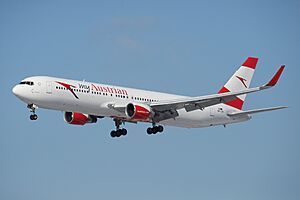
Before this merger, Austrian announced a new look called "my Austrian" in March 2015. It included a new company design and updated plane colors. However, in January 2016, Austrian Airlines decided to remove the word "my" from its branding.
In June 2015, Austrian Airlines bought 17 Embraer 195 planes from the Lufthansa Group. These Embraer planes replaced the older Fokker 70s and 100s. By late 2017, all Fokker planes were phased out. That same year, Austrian started offering internet on its short and medium-haul flights.
60th Anniversary and Beyond (2018)
In 2018, Austrian Airlines celebrated its 60th anniversary. It launched a new brand identity, including a new logo and new colors for its planes. This new look was designed to be more modern. It won a Red Dot Design Award in 2019.
Because of more competition from other airlines, Austrian announced changes to its planes and routes in 2019. By March 2021, Bombardier Q400 turboprop planes were replaced by Airbus A320s. All crew bases outside Vienna were closed. Routes not going through Vienna airport were moved to Lufthansa or Eurowings. In January 2020, Austrian also announced it would retire three of its six Boeing 767-300ER planes.
Recent Developments (Since 2020)
From March 18 to June 15, 2020, Austrian Airlines stopped all regular flights. This was due to the COVID-19 pandemic which caused air travel to stop around the world. During this time, the airline flew special flights to bring Austrians home from other countries. It also carried medical supplies. These flights went to places like Bali and Sydney.
In the summer of 2020, the airline received €600 million in financial help from Lufthansa and the Austrian government. In return, Austrian Airlines promised to cut its CO2 emissions in Austria by 50% by 2030. In 2020, the airline flew 3.1 million passengers, a big drop from the year before.
In September 2021, Austrian Airlines announced it would stop all its remaining scheduled flights that started from airports outside of Vienna. These flights were either canceled or given to its sister company, Eurowings.
In the fall of 2023, an Austrian court told Austrian Airlines to stop advertising flights using SAF (Sustainable Aviation Fuel) as "CO2 neutral."
Starting in the early 2020s, Austrian began updating its fleet of planes. In late 2022, Austrian ordered four new Airbus A320neo planes. The first of these arrived in October 2022. In April 2023, Austrian announced it would replace its long-haul planes (Boeing 767-300ER and Boeing 777-200ER) with 10 Boeing 787-9 planes between 2024 and 2028. Five of these jets came from Lufthansa, and five more were new deliveries. In early 2024, Austrian confirmed it would receive 11 Boeing 787-9s in total. Two of these were previously used by Bamboo Airways. In summer 2025, Austrian confirmed plans for a 12th 787-9 aircraft by 2028.
In January 2025, Austrian announced it would retire its three remaining Boeing 767-300ER planes by the end of the year. The last scheduled flight for these planes was Vienna-Washington D. C., by December 31, 2025.
How Austrian Airlines Works
Austrian Airlines Group is fully owned by Österreichisches Luftverkehrs Holding (ÖLH). This company is made up of Österreichische Luftverkehrs Privatstiftung (ÖLP), which owns 50.2% of the shares, and Österreichische Luftverkehrs-Beteiligungs-GmbH, a part of Lufthansa, which owns the rest. Austrian Airlines also owns parts of other companies, like Austrian Technik Bratislava, which fixes planes.
myAustrian Holidays
Austrian myHoliday became the new holiday brand for Austrian Airlines in 2013, replacing Lauda Air. It was renamed myAustrian Holidays in 2015. This part of the company runs special holiday flights, sometimes with tour operators. Austrian Airlines planes and crew operate all these flights. In 2017–18, holiday flights were offered to 40 places in ten countries.
Plane Colors and Design
Austrian Airlines' planes have always used red, white, and red colors, like the national flag of Austria. From the 1950s to the 1980s, the bottom of the planes was silver. The top was white with the Austrian Airlines arrow and text. The airline's old slogan was "the friendly airline." In 2015, the blue on the bottom of the planes and engines was changed to white and red.
The Austrian Airlines arrow, called the "Austrian Chevron," has changed over the years. In 1960, it looked like a flying bird. In 1972, it became more formal. In 1995, the "Chevron" was placed on the red-white-red tail. Since 2003, a more modern version of the old "Chevron" shape has been used.
The airline has also used special designs on its planes. Some planes have Star Alliance markings. For the Mozart year in 2006, an Airbus A320 had a Mozart design. An Airbus A340-300 honored the Vienna Philharmonic orchestra. Other planes had designs for the Euro 2008 soccer tournament. For its 50th anniversary, an Airbus A320 had old-style colors. Austrian's current slogan is "the charming way to fly."
Where Austrian Airlines Flies
Route Changes Over Time
In 2006, Austrian decided to stop using its A330 and A340 planes. These planes were sold to other airlines. Because of fewer long-haul planes, Austrian Airlines stopped some of its long-distance flights to East Asia. Flights to Shanghai (which restarted in 2016), Phuket, and Kathmandu ended in 2007.
In March 2007, the "Kangaroo Route" to Australia ended. Austrian was the last European airline to offer direct flights from Melbourne to Europe. Austrian Airlines temporarily restarted the Vienna to Sydney route in March 2020. This was to bring people home who were stuck during the COVID-19 pandemic. The flight from Vienna to Sydney was non-stop. The return trip stopped in Penang, Malaysia, for fuel and cargo. This non-stop flight was over 16,000 kilometers (10,000 miles) and lasted almost 18 hours. It was the longest flight in Austrian Airlines' history.
Austrian was one of the few airlines to fly to post-war Iraq when it started flights to Erbil in December 2006. New flights to Mumbai began in November 2010. Austrian resumed flights to Baghdad in June 2011. In January 2013, Austrian Airlines stopped flights to Tehran due to low demand. Austrian Airlines restarted flights to Chicago in May 2013 and launched Newark in 2014. Austrian Airlines started service to Mauritius and Miami in October 2015.
Austrian Airlines began service to Los Angeles on April 10, 2017. This flight covers over 9,877 kilometers (6,137 miles) and takes about 12 hours and 30 minutes. It uses Boeing 777-200ER planes. Austrian Airlines also started service to Shiraz in July 2017, with a stop in Isfahan, using Airbus A320 planes.
Austrian Airlines works with many other airlines through "codeshare agreements." This means they sell tickets for flights operated by other airlines, and vice versa. This helps passengers connect to more places around the world.
- airBaltic
- Air Canada
- Air China
- Air France
- Air India
- All Nippon Airways
- Asiana Airlines
- Azerbaijan Airlines
- Bangkok Airways
- Belavia
- Brussels Airlines
- Cathay Pacific
- Croatia Airlines
- Egyptair
- Ethiopian Airlines
- Eurowings
- Georgian Airways
- Iran Air
- ITA Airways
- KM Malta Airlines
- LOT Polish Airlines
- Lufthansa
- Luxair
- Scandinavian Airlines
- SunExpress
- Swiss International Air Lines
- TAP Air Portugal
- TAROM
- Thai Airways International
- Ukraine International Airlines
- United Airlines
Austrian Airlines Fleet
Current Aircraft
As of April 2025, Austrian Airlines uses these planes:
| Aircraft | In service | Orders | Passengers | Notes | ||||
|---|---|---|---|---|---|---|---|---|
| C | W | Y | Total | Refs | ||||
| Airbus A320-200 | 29 | — | — | — | 174 | 174 | ||
| Airbus A320neo | 5 | 6 | — | — | 180 | 180 | ||
| Airbus A321-100 | 3 | — | var. | — | var. | 200 | ||
| Airbus A321-200 | 3 | |||||||
| Boeing 767-300ER | 3 | — | 24 | 30 | 157 | 211 | To be retired by 31 December 2025. | |
| Boeing 777-200ER | 6 | — | 32 | 40 | 258 | 330 | To be replaced by Boeing 787-9 by 2028. | |
| Boeing 787-9 | 2 | 5 | 26 | 21 | 247 | 294 | 2 were taken over from Bamboo Airways in 2024. 5 to be transferred from Lufthansa. |
|
| — | 5 | TBA | 5 to be delivered new until 2028, for a total of 12 787-9 aircraft, including ones taken over from Bamboo Airways and Luftansa. |
|||||
| Embraer 195 | 17 | — | — | — | 120 | 120 | To be retired by 2028. | |
| Total | 68 | 9 | ||||||
Past Aircraft
Austrian Airlines has used many different types of planes in the past. These include the British Aerospace 146, Douglas DC-3, and Hawker Siddeley HS 748.
| Aircraft | Introduced | Retired | Notes/refs |
|---|---|---|---|
| Airbus A310-300 | 1988 | 2004 | |
| Airbus A319-100 | 2004 | 2022 | Sold to Lufthansa CityLine |
| Airbus A330-200 | 1998 | 2007 | Sold to TAP Air Portugal |
| Airbus A340-200 | 1995 | Sold to French Air Force | |
| Airbus A340-300 | 1997 | Sold to Swiss International Air Lines | |
| Boeing 707-320 | 1969 | 1971 | |
| Boeing 737-600 | 2008 | 2012 | Former Lauda Air fleet |
| Boeing 737-700 | 2008 | 2012 | |
| Boeing 737-800 | 2010 | 2013 | Former Lauda Air fleet |
| Bombardier CRJ100 | 1994 | 2010 | Former Lauda Air and Tyrolean Airways fleets |
| Bombardier CRJ200 | 1996 | ||
| De Havilland Canada Dash 8-400 | 2012 | 2021 | Former Tyrolean Airways fleet |
| Douglas DC-8-63CF | 1973 | 1974 | |
| Fokker 50 | 1988 | 1996 | |
| Fokker 70 | 1995 | 2017 | Former Tyrolean Airways and Slovak Airlines fleets |
| Fokker 100 | 2004 | ||
| McDonnell Douglas DC-9-32 | 1971 | 1990 | |
| McDonnell Douglas DC-9-51 | 1975 | 1985 | |
| McDonnell Douglas MD-81 | 1980 | 1999 | |
| McDonnell Douglas MD-82 | 1983 | 2005 | |
| McDonnell Douglas MD-83 | 1993 | ||
| McDonnell Douglas MD-87 | 1987 | Launch customer | |
| Sud Aviation SE-210 Caravelle | 1963 | 1973 | |
| Vickers Viscount | 1958 | 1971 |
Services on Board
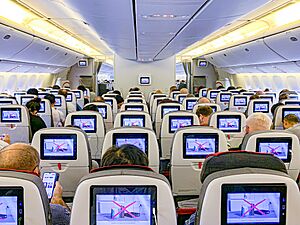
Austrian Airlines has several lounges at its main airport in Vienna. These are special areas for passengers to relax before their flights.
Since 2007, a company called Do & Co has provided the food and drinks on Austrian Airlines flights.
By 2011, all Austrian planes in the Airbus A320 family got new seats and a new cabin look. By September 2013, all of Austrian's long-haul planes (Boeing 767 and Boeing 777) also received new seats and cabin designs. This included flat beds in Business Class and new seats with video screens for every passenger in Economy Class.
Safety and Incidents
Here are some notable incidents involving Austrian Airlines planes:
- On September 26, 1960, an Austrian Airlines Vickers Viscount crashed near Sheremetyevo International Airport in Moscow. 26 of 31 passengers and 5 of 6 crew members died. The plane was flying from Vienna to Moscow. An altimeter (a device that measures height) problem was likely the cause. This was the only fatal accident for the airline.
- On February 21, 1970, a bomb exploded in the cargo area of an Austrian Airlines Sud Aviation Caravelle. The plane was flying from Frankfurt to Vienna. It created a hole in the plane, but the pilots safely landed back in Frankfurt. A group called the Popular Front for the Liberation of Palestine claimed responsibility.
- On January 7, 1997, Austrian Airlines Flight 104 from Berlin to Vienna was hijacked. A man with a small knife forced his way into the cockpit. The pilots flew back to Berlin so he could talk to authorities about his visa. Special police forces then took over the plane and captured the hijacker.
- On January 5, 2004, an Austrian Airlines Fokker 70 crash-landed in a snowy field near Munich International Airport. The plane was flying from Vienna to Munich. Its engines stopped working during landing because of ice. The plane was badly damaged, but only three passengers had minor injuries.
- On June 9, 2024, Austrian Airlines flight 434, an Airbus A320-200, flew into a thunderstorm while landing in Vienna. Hail tore off the plane's nose cone and smashed the cockpit windows. The plane landed safely in Vienna, and no one among the 179 people on board was hurt. The plane was repaired and returned to service.
See also
 In Spanish: Austrian Airlines para niños
In Spanish: Austrian Airlines para niños


